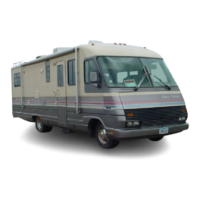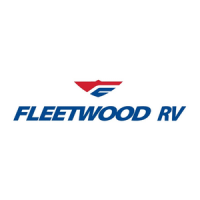75
Discovery, Discovery LXE, Pace Arrow, and
Steps to help control pests:
Reduce clutter inside the
motorhome and storage
bays. All storage items,
particularly food (including
pet food), should be kept
in tightly sealed containers.
Seal all cracks and holes,
and insure that window,
door and vent screens are
securely in place.
Routinely clean the
motorhome, including
storage bays. Wipe down
the water bay. Promptly
remove all crumbs from
areas where food is
regularly prepared and
eaten. Garbage should
be placed in a sealed
container and removed to
an outside receptacle daily.
Only put out pet food that
will be immediately eaten.
Keep foods such as our,
cereal, spaghetti and
pet food in resealable
containers with tight lids.
Sweep and vacuum often
(especially in eating areas)
to help eliminate a food
source for pests.
Pests seek indoor shelter
with food and water.
Limit their access to water
or moisture sources by
sealing cracks and leaks
in pipes and faucets.
Reduce moisture in the
motorhome by controlling
condensation, immediately
wiping up spills and
promptly repairing leaks.
Be extra alert around
areas that attract rodents
and insects, including
the sewer hose, fresh
water hose, bay doors
and items that may be
leaning against the outside
of the motorhome, such
as shing poles and golf
clubs. When the
motorhome is stored
outdoors, clear the
surrounding area of all
rodent friendly hiding
places: shrubs, trees
and clutter. Completely
seal the underside of the
motorhome. Wire mesh
will work well to prevent
points of entry, but beware
of blocking necessary air
vents. Prior to operating the
motorhome after storage,
remove all insect and
animal nests that may have
developed around vents,
engine compartments, the
exhaust pipe and in the
wheel wells.
Seal cracks, crevices, and
gaps around doors and
windows.
Rodents:
Rodents may chew through wires
or build nests in components of
the motorhome. Signs of rodent
infestation include droppings,
shredded material or chewed
furniture fabrics and vinyl.
Rodents like to build nests with
wire insulation and are commonly
attracted to the outside coating of
120 Volt AC wiring more than 12
Volt DC wiring.
NOTE:
Although the back cap
of the motorhome is well
sealed, rodents are capable
of chewing through the
foam insulation and that
area should be routinely
inspected.
If signs of rodent infestation
exist around the motorhome, place
traps or poisons in suspected areas.
Keep traps and poisons safely
away from pets and children.
Cheese is not the best bait for a
rodent trap. Use peanut butter or
chocolate in small amounts.

